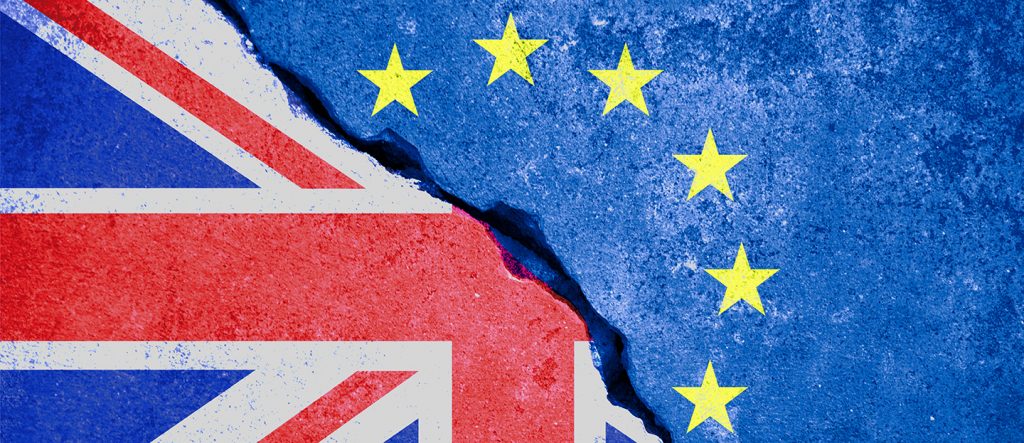Brexit crunch time for the UK and its relationship with the European Union.

This month, Prime Minister Theresa May is set to trigger Article 50 – the formal process by which the UK will quit the EU. There’s been much debate over what a post-EU world look like but there seems to be no more clarity about what life will be like once the UK has left the EU than when the British public voted by a slender majority to walk away last year.
The issues are myriad: Immigration, tariffs, market access and currency fluctuations to name just three. And then there’s the risk that some manufacturers might just exit the UK and head for the continent. So the key question remains for the country’s packaging sector: will it be better or worse off under Brexit, hard or otherwise?
Negotiations between the UK and Brussels are likely to last two years. However, the desire to limit immigration into the UK means access to the single market is being ruled out, while doubts hover over the customs union. Many manufacturers are dismayed at this, not least around the movement of people. The ease with which EU citizens would be able to come and work in the UK – and the residency status of those already here – could prove to be vital to many firms operating in the packaging sector.
Labour flexibility
So while tariffs and input costs are a concern, “by far the biggest issue is the flexibility of labour”, says Rodney Steel, chief executive of the British Contract Manufacturers and Packers Association (BCMPA), which is particularly important given the seasonal nature of a lot of packaging operations, notably agriculture and the run-up to Christmas.
A significant number of the BCMPA’s member companies rely on workers coming from Eastern Europe, Steel adds. He believes their ability to come here – indeed their desire, in the light of changing social attitudes towards those from that part of the world – hangs in the balance.
The possible decline in numbers of EU workers involved in seasonal activity might be balanced by an increase in the number of UK employees, although the consensus is that firms that have had problems finding ‘local’ people willing enough to do the work will continue to have such problems.
Additionally, while the importance of the UK packaging industry’s contribution to the domestic economy – valued between £11bn and £12bn annually – is not to be underestimated, the sector very much depends on the fortunes of its customers, many of whom may be taking a view on their trading activity within the UK and further afield.
As Dick Searle, chief executive of the Packaging Federation, points out, around half of the food consumed in the UK is imported. “Market access is vital and has significant implications for the food and drink industries, particularly with regards to cross-border activity.” And with doubts over the customs union, he wonders: “Can you imagine what will happen at ports like Dover, with every transport being checked?”
Martin Kersh, chief executive of the Foodservice Packaging Association, agrees: “Food packaging is time critical. It can’t afford to be held at customs posts.”
The issue of regulation is another potential minefield. The industry will seek to maintain high standards – in areas such as food contact, for example – and few will be willing to compromise, despite some MPs suggesting that Brexit will ease the burden of red tape. “[Conservative MP] Jacob Rees-Mogg’s recent line that ‘if it’s good enough for India, it’s good enough for us’ on standards was appalling,” says Kersh. “We must not compromise. If the government lowers its guard we will be inundated with packaging that is sub-standard.”
Philip Law, chief executive of the British Plastics Federation, says the industry had “fought long and hard” to achieve regulation that was both valuable and acceptable. “So we must have ‘regulatory equivalence,” he adds. “We might not necessarily like the [Brussels’] regime, but we can work within it.”
Searle agrees. “So much of what we do is tied up with the EU, and disentangling ourselves from that is going to be a challenge. The only thing that appears certain is that there is going to be a lot of uncertainty ahead.”
With that in mind, the sector needs clarity from the government, says Kersh, although this has not been especially forthcoming. Perhaps this is understandable.
“Being a service industry we’re not ‘seen’,” he says. “Compared with sectors like automotive and the chemical industries we’re not very high on ministers’ agenda, despite the financial and employment contributions the sector makes.”
As part of a sophisticated supply chain, the packaging industry ought to be well placed to sway ministers, argue some. But Searle asks: “Are people listening? They hear what we say, but the important bit is getting them to act.”
So what should the industry do? “We have to be clear about what we want and talk to customers we sell to and try and ensure freedom of trade and no tariffs,” Kersh says.
Investment decisions
Meanwhile, is it likely that firms with UK operations but EU-based headquarters might up sticks and leave? Some believe there is a danger that with the UK no longer a hop-off point for the lucrative markets in the EU, such firms might divert investment elsewhere or indeed transfer operations out of the UK. But while anecdotal evidence suggests that some investment decisions are being mulled over, plans to relocate seem a way off.
While the pervading feeling is one of uncertainty is there any Brexit upside for the UK packaging sector? Searle, who warns of the likely impact of rising input costs, thanks largely to sterling’s depreciation against pricing currencies such as the US dollar and the euro, says: “The industry is hugely innovative and extremely resilient. We could potentially become more sufficient in food production. But we need access to markets, we need to be more competitive and we need more skills.”
Rodney Steel highlights that in times of uncertainty brand owners often outsource, which can have mixed outcomes but could prove to be a ‘plus’ for the sector, while the BPF’s Law says: “There might be more consumption of UK-produced, UK-packaged goods. But that’s speculation.
“What we do know is the packaging sector will make the best fist of the cards it has been dealt. It has survived past crises and I’m pretty confident it will cope.”
THE KEY BREXIT CHALLENGES
EU workers, UK industry, regulation and standards
The packaging industry sees in Brexit more challenges than glaring opportunities. Primarily, fears revolve around the ability of EU citizens to work in the UK, while there is also the threat of tariffs, the possibility of the UK’s isolation from key European markets, and a lowering of quality standards.
The FPA’s Martin Kersh says: “In setting [employee] quotas and work permit criteria will the government insist on a very high education level? If so, manufacturing, warehousing and distribution will be even more short of labour, while some companies will find it difficult to trade, what with staff returning home and quotas preventing their replacement.”
Retaining this EU workforce will be crucial, says the Packaging Federation’s, Dick Searle. “Without them, much of the UK’s industry would grind to a halt. So many structural issues across our economy have been hidden by the good work these people do.”
Philip Law of the BPF agrees, and also highlights the issue of regulation. “It is vital that we continue to influence legislation and standards in the EU, as it will continue to be a very significant market for UK packed goods.” There is concern that instead of appreciating such standards, the UK government will view them as needless bureaucracy. Kersh says: “While I believe UK packaging manufacturers will keep to the current standards, and continue to change as they do within the EU, I feel the floodgates to substandard, currently ‘illegal’ packaging will be opened, risking the safety of the UK population.”
BREXIT TIMELINE
June 2016
After one of the most acrimonious political campaigns in recent times, the UK votes by 52% to 48% to leave the EU. David Cameron, who called for the referendum, resigns as Prime Minister.
July 2016
Former Home Secretary Theresa May becomes Prime Minister and promptly appoints prominent ‘Leave’ campaigner Boris Johnson as the UK’s new Foreign Secretary.
August 2016
In what is a traditionally quiet period on the politics front, MPs are told that “Brexit means Brexit”, although no-one quite knows what this means.
September 2016
Low unemployment figures and strong consumer spending prompt pro-Brexit commentators to claim the UK can thrive outside the EU.
October 2016
Prime Minister Theresa May announces details of the government’s Great Repeal Bill – which among other things will convert existing EU law into UK law – to delegates at the Conservative Party’s annual conference.
December 2016
The Supreme Court backs an earlier judgment by the High Court in November and rules that Parliament is entitled to vote on the government’s bill for Brexit before Article 50 can get underway. The government had appealed to the Supreme Court to quash the High Court’s ruling and prevent such a vote.
January 2017
Prime Minister Theresa May finally outlines her aspirations for Brexit. She rules out the UK remaining in the single market, prompting concern among many in the business community.
February 2017
Put to a vote by MPs, the government’s bill paving the way for the triggering of Article 50 gets overwhelming support. Some 494 MPs voted in favour of the bill, which went through unamended, with 122 against.
March 2017
Prime Minister Theresa May set to officially starting the process for the UK to leave the EU.
 Why use A&A Packaging? A&A Packaging strives to aid the busy buyer with an efficient and personal service, providing product advice, specialist product sourcing, and problem-solving to make your life easier.
Why use A&A Packaging? A&A Packaging strives to aid the busy buyer with an efficient and personal service, providing product advice, specialist product sourcing, and problem-solving to make your life easier. According to reports in The Grocer, Doritos, Peparami and Coc Pops have all reduced the size of packs at a time when costs are rising due to the falling pound.
According to reports in The Grocer, Doritos, Peparami and Coc Pops have all reduced the size of packs at a time when costs are rising due to the falling pound.